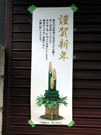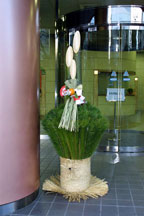| Эта традиция берет свое начало в Китае. В Китае в ворота втыкали ветку сосны, чтобы
выразить почтение божеству ворот.
В Японии было обычаем укрепить на воротах ветку сосны и натянуть Симэнава - соломенную гирлянду,
украшенную нарезанной бумагой.
|
これは元は中国から伝わったものです。中国では、年の神をまつるために松の枝を門に差しました。
日本では、門に常緑樹の小枝を置き、注連縄をはる習慣がありました。
|
Originally it derives from China. In China they put a branch or twig of pine at the gate to worship the god of the gate.
In Japan, it was customary to put a twig of an evergreen tree and stretch Shimenawa, a straw festoon decorated with cut paper at their gate.
|
|
Это является знаком для божества года, когда он будет спускаться на землю. Сосна (мацу)-
вечнозеленое дерево.
Так как она всегда зеленая, то никогда не увянет и не умрет.
Поэтому сосна является счастливым символом.
|
これは、年の神が降りてくるときの目印なのです。
松は常緑樹です。常に緑で枯れないので、めでたいとされています。
|
It is a target for a god of the year to descend, when he comes down to the earth.
Matsu, pine is an evergreen tree. As it is always "green" and it will not wither or die. So, it is regarded as a happy symbol. |
|
В эпоху Камакура традиция начиналась с того, что связывали три побега бамбука и вокруг
них укрепляли сосну. Все это три раза связывали соломенными веревками. |
鎌倉時代、三本の竹を縛り、まわりに松を置く習慣が始まりました。縄で三回巻いたのです。
|
In the Kamakura era, a custom began to tie three bamboo shoots and arrange pine around them.
They tied it three times with straw ropes.
|
|
Мы ставим две Кадомацу. Слева - мужское дерево, справа - женское.
Обычно
укрепляются две ветки сосны на воротах дома.
|
門松は一組で立てます。左側は雄松、右側が雌松です。
普通は、家の玄関に一組の松の枝を立てます。
|
We put a pair of Kadomatsu. Left one is a male, and the right one is female.
Usually we put just a pair of pine twigs at the entrance gate of our house. |
| Некоторые люди вешают на дверь изображение Кадомацу. |
中には、門松の絵がある紙を戸に貼り付ける人やお店もあります。
|
Some people put a picture of Kadomatsu on their door.
|
| Период с 1 по 7 января называется "мацу но ути" или "внутри сосны.
В эпоху Эдо Кадомацу стояла до 15 января. Затем она сжигалась и церемония называлась "дондо яки".
|
1月1日から7日までの期間は、「松の内」と呼ばれています。
江戸時代には、1月の15日まで、門松を立てていました。それからどんど焼きという儀式で焼かれました。
|
The period from January 1 to January 7 is called "Matsu no uchi" or “The period inside the pine.”
In the Edo era, they put Kadomatsu until January 15. Then it was burned at a ceremony called "Dondo yaki".
|
|
|
|
Copyright c 2001, Nobutoshi KOHARA - Japanese original; general editing.
Copyright c 2001, Elena Zaitseva - Russian translation.


